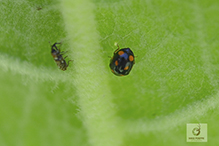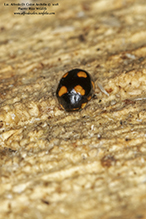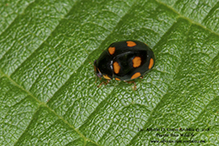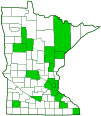ursine spurleg lady beetle
(Brachiacantha ursina)
Conservation • Description • Habitat • Ecology • Distribution • Taxonomy
Conservation Status |
|
|||||||
| IUCN Red List | not listed |
|||||||
| NatureServe | NNR - Unranked |
|||||||
| Minnesota | not listed |
|||||||
Description |
||
Ursine spurleg lady beetle is a small lady beetle. It occurs across the United States and southern Canada. The body is elongated oval when viewed from above, hemispherical when viewed from the side, ⅛″ to 3 ⁄16″ long (3 to 4.5 mm) long, and 1 ⁄16″ to ⅛″ (2.1 to 3.2 mm) wide. The head is deeply inserted into the thorax, but is visible from above. On the male the head is black but the upper face (frons) is mostly yellow. The plate just above the mouth (clypeus) may be slightly darker or brown. On the female the head is yellow except for the clypeus, which is brown or black. The antennae have 11 segments. They are very short and club-shaped, thicker near the tip than at the base. The upper thoracic plate (pronotum) is convex and wider than long. It is black with a large yellow to orange spot at each front corner. On the male it has a narrow yellow to orange front margin. The triangular plate (scutellum) between the bases of the hardened forewings (elytra) is small, triangular, and wider than long. The elytra are strongly convex and very narrowly flattened at the margins. They completely cover the abdomen. They are black with five yellow to yellowish-orange spots on each elytron. They are shiny but are covered with fine pits (punctures) that make them look slightly dull. In our area (the Midwest) the spots sometimes converge, making the elytra mostly yellow to yellowish-orange. The legs are yellowish-brown. The fourth segment (tibia) of the front legs has a spine that faces to the side. This is the feature that gives the beetle its common name. The tibiae on the middle and hind legs has two spurs at the tip. The last part of each leg (tarsus), corresponding to the foot, has four segments, but the third segment is very short and tucked within the extended lobes of the second segment, making the leg appear to have only three segments. The tip of the last tarsal segment on the middle and hind legs has a pair of claws. Each claw has a large tooth at the base. |
||
Size |
||
Total length: ⅛″ to 3 ⁄16″ (3 to 4.5 mm) |
||
Similar Species |
||
Habitat |
||
|
||
Ecology |
||
Season |
||
May to July |
||
Behavior |
||
|
||
Life Cycle |
||
|
||
Larva Food |
||
Scales (Coccidae) in the nests of ants. |
||
Adult Food |
||
Adults are often found on milkweed (Asclepias spp.) |
||
Distribution |
||||
|
Sources |
|||
| 6/25/2022 | ||||
Occurrence |
||||
|
||||
Taxonomy |
|||
Order |
Coleoptera (Beetles) | ||
Suborder |
Polyphaga (Water, Rove, Scarab, Long-horned, Leaf, and Snout Beetles) | ||
Infraorder |
Cucujiformia | ||
Superfamily |
Coccinelloidea (lady, fungus, scavenger, and bark beetles) | ||
Family |
Coccinellidae (lady beetles) | ||
Subfamily |
Scymninae | ||
Tribe |
Brachiacanthadini | ||
| Genus | Brachiacantha (spurleg lady beetles) | ||
Synonyms |
|||
|
|||
Common Names |
|||
orange-spotted lady beetle ursine spurleg lady beetle |
|||
The term “ursine” means resembling a bear. This may have more to do with the imagination of the namer than to the appearance of the beetle. |
|||
Glossary
Clypeus
On insects, a hardened plate on the face above the upper lip (labrum).
Elytra
The hardened or leathery forewings of beetles used to protect the fragile hindwings, which are used for flying. Singular: elytron.
Frons
The upper front part of an insect’s face, roughly corresponding to the forehead.
Pronotum
The exoskeletal plate on the upper side of the first segment of the thorax of an insect.
Scutellum
The exoskeletal plate covering the rearward (posterior) part of the middle segment of the thorax in some insects. In Coleoptera, Hemiptera, and Homoptera, the dorsal, often triangular plate behind the pronotum and between the bases of the front wings. In Diptera, the exoskeletal plate between the abdomen and the thorax.
Tarsus
On insects, the last two to five subdivisions of the leg, attached to the tibia; the foot. On spiders, the last segment of the leg. Plural: tarsi.
Tibia
The fourth segment of an insect leg, after the femur and before the tarsus (foot). The fifth segment of a spider leg or palp. Plural: tibiae.
Visitor Photos |
|||||
Share your photo of this insect. |
|||||
| This button not working for you? Simply email us at info@MinnesotaSeasons.com. Attach one or more photos and, if you like, a caption. |
|||||
Mike Poeppe |
|||||
 |
|||||
Alfredo Colon |
|||||
 |
 |
||||
 |
 |
||||
MinnesotaSeasons.com Photos |
|||||
|
|||||

Visitor Videos |
|||
Share your video of this insect. |
|||
| This button not working for you? Simply email us at info@MinnesotaSeasons.com. Attach a video, a YouTube link, or a cloud storage link. |
|||
Other Videos |
|||


Created: 7/8/2019
Last Updated:




